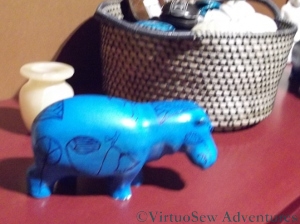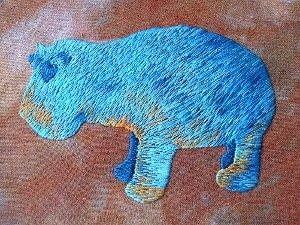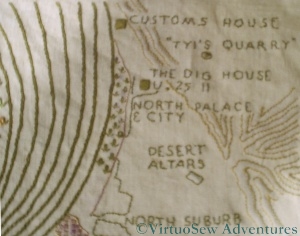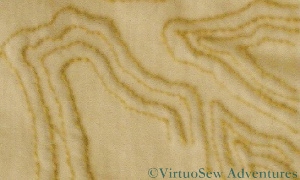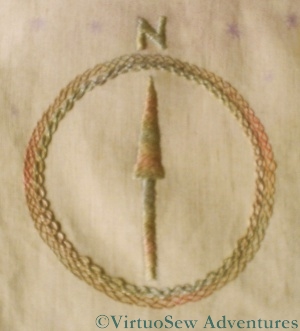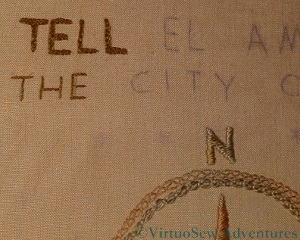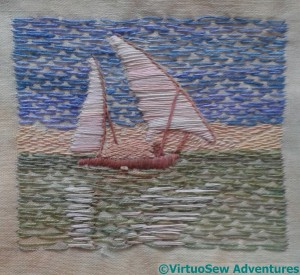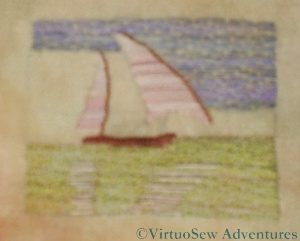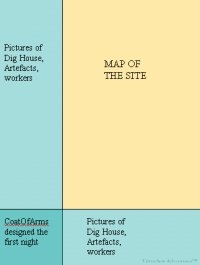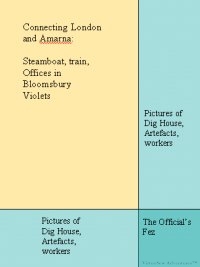Tag: Dreams of Amarna
Dreams of Amarna – More Research
This weekend I went to the exhibition “Tutankhamun – His Tomb and His Treasures” at the Museum of Museums near Manchester’s Trafford Centre. Partly just for fun, and partly because Mary Chubb mentions the huge excitement over Howard Carter’s discovery of Tutankhamun’s tomb as some of the “social background”, if you will, in her book “Nefertiti Lived Here”. I was hoping to catch some of the flavour of that excitement as well…
It was an excellent exhibition. The usual introductory hall, with panels describing ancient Egypt and the development of Egyptology, but this one also included a reproduction of the Rosetta Stone. I knew that one of the languages was hieroglyphic and the other was Greek, but I hadn’t quite registered that the third was demotic, which was the “workday” script of ancient Egypt, as it were. Then there were films about Tutankhamun, and about Howard Carter, and then we turned a corner and found ourselves face to face with a reproduction of the antechamber of the tomb, just as Carter would have seen it. There is a British Museum page showing one of the original photos here. Except that doesn’t begin to give you any sense of the impact, because nearly every item is covered in gold. It speaks volumes for the self-discipline of Carter and his colleagues that the whole affair did not degenerate into a snatch and grab. I was too startled and overwhelmed to take a photo at this point, although non-flash photography was permitted.
Although I knew, of course, that the tomb contained a mixture of Amarna-period pieces and later pieces, I wasn’t aware that the cloisonné on the middle sarcophagus (close-up above) was an explicitly Amarna period design. So maybe I need to do a small patch using that pattern.
I took quite a lot of photos, which came out, on balance, much better than I expected them to, and may even turn out to be interesting and useful.
There was a short exhibition at the end which included some of Howard Carter’s watercolours – he was clearly a very fine archaeological artist and illustrator, and then we were sent out though the inevitable shop. Where I couldn’t fail to take one final photo…!
Still More Work on the Map of Amarna
This photograph shows a completed section of the Amarna Map, which demonstrates most of the design choices I have made as I went along.
The long lines to the left in the picture are worked simply in Chain stitch and represent the Nile that runs beside the site. Small tête de boeuf stitches represent the cultivation, represented by hatched stars on the original map.
The text is worked in Back Stitch. It isn’t perfectly regular, but it isn’t really intended to be, either. I knew that all my favourite line stitches would be too heavy and detailed for the scale and the intention I have, so it is deliberately chosen to be as simple as I can make it.
Remember there will be areas competing for attention here and that what I want is a general impression that the viewer can then look at more closely if they want details.
There is at least as much again to do before the Map is finished – that’s why I have tagged this post “Perseverance”!
Some Work On The Map of Amarna
Fortunately for me, I’d already had plenty of ideas for working the Map of Amarna for the first of the background panels, and in fact, as soon as I decided to include it there was one section about which I was absolutely certain – the contour lines. I’ve worked them in Reverse Herringbone Stitch. The fabric between the lines is thus slightly raised – padded by the threads behind it. I got this far on the map quite some time ago and was very pleased with myself when it turned out Just As I Hoped.
Then I moved on to another section and found myself struggling. In the drawn map, the compass rose is indicated by three lines. When I tried that, it looked clunky and rather sad. So I returned to my stitch dictionaries, and looked for line stitches. Cable Chain Stitch was an obvious choice, as it has been a favourite of mine for years, and the outer ring is worked in Closed Feather Stitch. I used two Caron Collection threads in the same colourway here – a single strand of the heavy pearl cotton type which has three strands (Watercolours, I think it is called), and the much finer one, which I think is Wildflowers. It is interesting to watch the colour changes as they appear very different and have different emphases in the different threads.
I may yet decide to run a “shadow” to one side or the other of the arrow, using a simple stitch such as stem stitch, to throw the satin stitch into stronger relief, but for the moment I am happy that the flatter outer ring creates the illusion of a raised compass rose, while still being clearly something stitched.
Dreams of Amarna – The Title on the Map
I described the first of the background panels I am planning for the Dreams of Amarna a few months ago. I will describe some of the other stitching I have done on it in another post, but I have been racking my brains since I began stitching, trying to work out how to embroider the title.
The challenge I am facing with the whole map is that I want it to be clear that it is embroidered, not screen-printed, but at the same time, I don’t want to show off every stitch I know or produce something that is so heavily stitched that it pulls the final pair of panels out of balance. So far, every time I have tried something it has been too prominent or too fiddly or Just Plain Wrong. While this is disheartening, one of the advantages of the butterfly mind is that I could stow the piece away and work on something else while waiting for inspiration.
Then suddenly, a few days ago, the Gordian Knot was loosed. I’m using ordinary stranded cotton (two strands) in the darkest shade I am allowing myself. It’s not overdyed or textured, and I am using the same thread for both rows of text.
The large text uses the Chain Stitch with Buttonhole Edging that I learnt in Month Five of the Tudor and Stuart Goldwork Masterclass. I knew it would be useful as soon as I saw it! It is slightly fiddly to work at this scale, especially using stranded thread, but importantly, it doesn’t look fiddly when it is in place.
The smaller row of text below it is in split stitch. This provides a narrow, unbroken line, again clear enough to be readable, but equally not drawing attention to itself. If I decide later that this row is a little too unassuming I can always whip the split stitches!
This now means that I know what I am doing with this panel for a while yet, and can just get stitching on it. Unfortunately the transfer that I made has worn off the centre of the fabric so a large section of map will have to be retraced and reapplied, but that can wait until I have finished the titles.
I’m greatly relieved. I’ve now got plenty to work on while I think of the next idea…
The Felucca Is Finished
I have finished the first trial of the Felucca design. As I always say of these design fragments, I do not yet know whether they will make it to the final piece.
You can barely see the stitching on the coastline – I used a fine thread and spaced the stitches far apart. For the cargo, I crammed the stitches as close to one another as I could. The sails are worked in Satin Stitches rather than darning, and the spars in Stem Stitches. I’ve decided I am happy with the pinkish tinge on the sails, and the greenish Nile is just as I imagined it would be.
I think it has worked. The reflections of the sails bring the whole piece to life, and I added some small stitches to provide an impression of a reflection of the spars.
The Felucca – Second Stage
I’m afraid that this photo isn’t as good as I hoped it would be, but it does show the progress I am making on the Felucca.
I realised that not only did I need to have the sails completed before I put all of the sky in, but I needed to put the Nile in before I put in the reflections.
So I’ve done the Nile – nearly. If you look carefully you will see that there is a small section of Nile behind the Felucca which hasn’t been finished yet. I’ve used the same irregular darning stitch as I used for the sky, and run in the reflections using long straight stitches in the spaces between the rows of green. I need to put a few more stitches in yet, but I’ve run up against rather a headache which I need to resolve.
I need to do the land behind the Felucca. I was intending to use a paler version of the reddish-brown thread I’m using for the hull and the spars. However, when I put it in, it really didn’t work. No, I mean it. Not At All. I’ve since tried a couple of other threads with no marked success, so I need to spend some time finding a suitable thread.
If you look at the photo on the original post, the tones of the sky, the Nile and the elements of the felucca are not quite correctly reproduced in my embroidered piece. Part of this is because the base fabric isn’t white so everything is turning out a little darker than I expected. I think it will work in spite of the changed tones, but I am anticipating working the design again in a different form or scale, maybe using different threads, so if in the end I don’t like it I will still feel I have learnt something useful!
Beginning the Felucca
I’ve begun to work on the Felucca design I have already described. As I am not at all sure about the colours or the stitching that I will want on the final panels (remember this is to be a design element for the edging panels I described a little while ago), or even the scale, I am thinking of working this design several times on different fabrics, with different threads and at different scales, to see which one I like best. I’m sure I will find something to do with any leftover pieces of embroidery!
This version is about two and a half inches by one and a half inches, and it is worked on turban cotton, just like the fabric I used for my earlier experiment with the Dig House. I’m using similar stiff overdyed linen threads as well, but this time I have learnt from the trouble I had with the Dig House. The fabric has been hooped up over a piece of calico, and although it is slightly irritating to have two layers to stitch through, it has a lot more body and is much easier to stitch.
I’ve put the design onto the fabric using a transfer pencil and began with the sky, using a sort of irregular darning stitch. Then I realised that if I were to work the sails first it might be easier to fill in the sky afterwards. I’m not entirely sure about the thread I am using for the sails – it may be a little too pink – but I think it will be hard to be sure before I have finished. I have a dark blue-green thread that will do the Nile perfectly (I hope), and I will be able to run lines of stitching in the hull and sail colours into the water section to make reflections.
This might become my evening stitching until I have finished it. Although it is small, the colours are distinct from one another, and the stitches don’t have to be as precise as they would if it were a counted piece.
EDIT: spelling improved!
The Felucca
The photograph here is a close up from one of those that the Egypt Exploration Society made available to me, and shows a Nile felucca in passage with a cargo.
Mary Chubb describes in her book the expedition’s arrival at the site on a felucca, one of the traditional sail-driven freighters of the Nile and Eastern Mediteranean. As she also mentions in the book (when they go on a tour of the Pyramids on first arriving in Egypt) that she is somewhat claustrophobic, it seemed to me that an open sailing vessel and the broad sky over the Nile were probably very important to her. As the felucca also took their finds back to Cairo for inspection by the Museum Director, it was very important to the Expedition as well.
So clearly the felucca should figure at least once in my Dreams of Amarna panels! Equally, however, I need to develop the styles of embroidery I will use for the panels and their assorted images. So I am never sure, when working on these small elements, whether they will end up as part of the final piece or not.
I’ve not even started stitching the Felucca yet, but I have decided that it will be another experiment. I am going to try to stitch the whole thing using straight horizontal stitches. This should emphasize the breadth of the space, which would have been so important to Mary. I am not going to attempt to fill the space, either, so the picture will look slightly sketchy, rather like a photocopy of a memory, perhaps.
Dreams of Amarna – More Planning
It occurred to me that now would be a good time to create some diagrams to show the design ideas that I have, so that when I refer to “backgrounds” or “side panels” it is clear what I mean.
The basic fabrics are dress-weight linens, one in a sandy colour (the High Desert is not that far away from the site) and the other two are in different turquoise shades, rather like faience.
I have not decided how wide the side panels will be, or how they will be attached. In some cases the design elements will be stitched separately (as the Faience Hippopotamus was) and then applied as a patch, and in others they will be stitched straight onto the base cloth. Again, I am not sure how I will decide what happens in each case. At present the project is progressing on those bits that I have made a decision on, and the more difficult matters are being left to one side.
John Pendlebury was fascinated by the medieval period as well, and over dinner the first evening they were at the site, Mary Chubb describes how they doodle a coat of arms for the dig. When I was a teenager I was fascinated by heraldry, so that was definitely going to be part of one of the panels; the fez is for an official at the Cairo Museum who acted as the intermediary between the Egypt Exploration Society and the Museum. The violets spring from Mary’s efforts to learn Arabic. More about that when I get there!
In reading the book, one feels as though Mary is haunted by the leading characters of the past – Akhenaten and his Queen, Nefertiti. She even finds herself imagining a visit by Nefertiti to the Dig House in the days when it was merely one of the houses of Aketaten. That is why all the activity on the panels will be overlaid by a faded “head shot” of either Akenaten or Nefertiti, screenprinted onto the finest and most transparent gauze I can find. I may decide to offset these a little so that the heads are over the tawny linen and all the bright elements around the outside have only the merest veil over them.There’s going to be a finishing problem right there, because I want the gauze to hang in front of the panels and not be stretched over them.
Still, we all like a challenge, don’t we?
The Faience Hippo Finished
So here is the Faience Hippopotamus finished. That is, unless I decide to go over him with another layer of long and short stitch to break up some of the patterning even further…
I’m reasonably pleased with him, as a matter of fact. The loose weave of the base fabric was sometimes challenging to work on, and it isn’t at all a hardwearing piece – some of the stitches are half an inch long, which would be bound to catch on something – but as it will be part of a carefully protected wall panel if it makes the final piece, this is not going to be a problem.
I enjoyed doing it, as well. It was fascinating to see the colours change more subtly when I started using the thread turned end-for-end, and this vibrant turquoise/teal colour is one of my favourites.
And, yes, I did manage to work an entire piece in long and short stitch. It is fair to say, I think, that it will never be my favourite stitch, but it does have its place, and I am certainly happier to use it now I have had Tricia’s instructions on the Floral Glove Needlecase Course.


